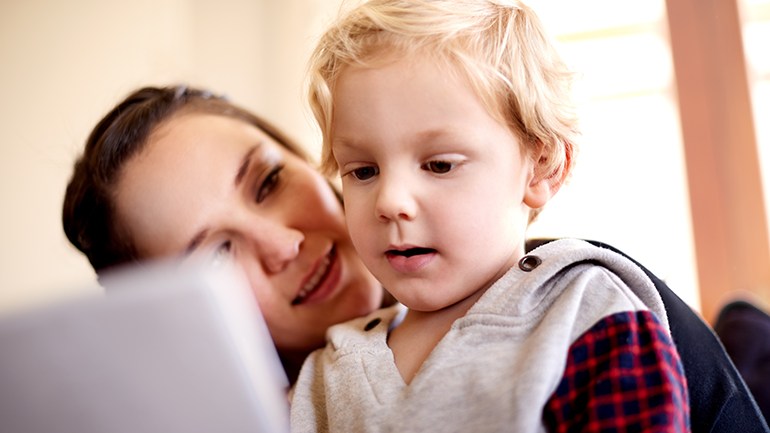
New guidelines on screen time for young children and tips to help your family unplug.
We’ve all been there: the pots are overflowing on the stove, the preheated pan is now smoking, the dog is howling to be let out, your toddler is crushing goldfish crackers into the carpet while the baby tries to eat a cushion. And we’ve all done the same thing at some point: turned on Netflix to babysit while we get dinner prepared. To help ease the guilt, we tell ourselves, "I grew up watching television and I turned out fine." But the truth is, reality has changed. Electronic devices, smartphones and tablets, are everywhere – even more so in the last five years – and it has experts concerned with the impact it may have on infant and toddler speech and language development.
So how do families balance digital and real life? Here are some facts on screen time and tips to help your family unplug.
New guidelines for screen time
The Canadian Paediatric Society released its recommendations on screen time for children:
- For children under two years old, screen time should be avoided (other than video chatting).
- For children ages two to five, screen time should be limited to a maximum of one hour per day. Choose high-quality educational programming, such as Sesame Street and other PBS Kids shows, and make sure to watch it together to help your children understand what they're seeing.
- For children ages six and older, place consistent limits on the time spent using media and the types of media, and make sure media does not take the place of adequate sleep, physical activity and other behaviours essential to health.
Parents are encouraged to view shows with their children so there is opportunity for conversation. Talk about what your child is seeing and seems interested in. Help relate what she sees (e.g. an airplane on the show) to her past experiences and knowledge (the last time they took a flight to visit grandma).
But what about those educational apps?
So you’ve downloaded that $2.99 ABC app and purchased one of those LeapPad devices thinking at least they are educational and my child will learn her alphabet and numbers before kindergarten.
Despite marketing tactics, research has shown that young children (ages 0-5) learn best when they are talking and engaging with other people. At this age, the root of learning comes from interaction. Playing, talking, singing and reading with your child helps build their vocabulary, develop their interests, and learn daily life lessons. More importantly, it teaches them how language is used in a social context.
Imagine taking a car ride with your child. If your child has an iPad in front of him, he will likely be sitting quietly watching his favourite show. While there is probably no doubt that he is enjoying himself and learning numbers and farm animal sounds, he is learning alone and without context.
Now imagine your child is engaged with you during your car ride. Perhaps you have the music playing and you are singing together. Perhaps you are pointing and naming the cars, trucks, and animals that you pass. Perhaps you are simply responding to the words and sounds your child makes. Through this simple interaction, he is learning a wide variety of words in real situations that have real meaning to your family. Perhaps most importantly, he is learning how language is used to form relationships and communicate with other people. These skills provide a strong foundation for future vocabulary and grammar development.
Replacing screen time with activities
We realize it’s easy to talk about reducing screen time but much more difficult to put into practice. Finding alternate activities doesn’t have to be complicated and fun games can be invented with materials you already have in your house. Try a few of these simple ideas:
- Toilet-paper tunnels. Tape some paper towel or toilet paper rolls into a long tube. Let your child drop cars, balls or marbles down the track and see how far they roll.
- Dress up. Start a tickle trunk with old shoes, clothes and jewelry for your child to play with. Check out your local thrift store for discounted costumes after Halloween.
- Race track. Use masking tape to make a race track on the floor for your child to drive cars along.
- Car wash. Fill a basin with soap bubbles and let your child put their toy cars through the car wash.
- Forts. Re-use those diaper boxes to build forts and throw in some blankets and pillows.
- Household tasks. Teach simple tasks such as sorting the recycle bin, getting ingredients out for cooking, or lining up the shoes in the hallway.
These types of independent free-play promote creativity and problem-solving.
Setting limits
In order for children to develop good habits, parents and family members have to model appropriate media use and set limits. Here are some suggestions:
- Set a timer so your child knows that once it beeps the iPad or TV must turn off.
- Designate media-free zones, such as the dinner table and bedrooms.
- If your child watches TV in the car, start with one screen-free day per week in the car. Alternatively you could only allow TV on certain trips (i.e., we can watch TV on long trips like when we go to grandma’s house, but not on short trips like when we go to preschool).
Learn more
Learn more about infant and toddler speech and language development.
